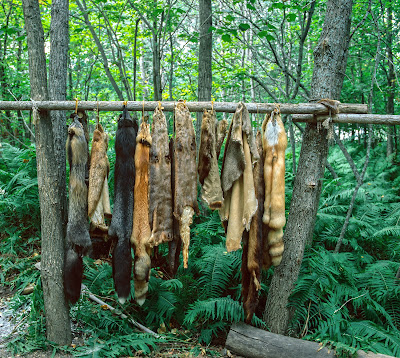For the
last two Lake Superior Days, I've turned this space over to my dear friend,
Philip Kucera. I'm pleased to do so again.
The Misty Isle
Mid-July, 1971.
My wife, Judy and I left Chicago after work in Friday rush hour traffic. We'd spent days planning our trip to Lake Superior's Isle Royale National Park. An easy 13-14 hour drive to Grand Portage, Minnesota before boarding the passenger ferry Voyager...I thought.
State Highway 61 was not the road of Bob Dylan fame.
We arrived at the dock 10 minutes before departure, ferry engine idling,
passengers aboard – including two of my uncles from Michigan who joined us for
the ride.
The first and only mate stepped ashore and helped with
our gear. When I dropped the umbrella tent out of the station wagon he said
with a near Canadian accent, "You're going to need a dolly to move
this!"
We liked our canvas tent; you could stand up in it.
Unsure if shelters would be available at the Park, it was loaded aboard.
Captain Roy Oberg, a highly respected North Shore navigator, entertained us and half dozen others with big lake tales and close-up views of the island. The ferry's twice weekly, two day clockwise circumnavigation of the place included an overnight stop at Rock Harbor.
Voyageur offloaded mail, groceries and supplies such
as block ice and empty fish boxes to a handful of family fish camps en route,
shuttling campers and loading freshly iced fish for mainland restaurants and
markets.
The old 48 foot vessel would be retired after the end of the season, Roy said. A sixty-three foot Voyageur II replaced it, more than doubling capacity along the same route. Today that carries backpackers and sightseers in place of trout and whitefish.
At Rock Harbor Captain Oberg asked where we were staying for the night. He noted our hesitation and said, "The boy set up a berth for you folks in the ship's cabin. Grab your sleeping bags, we'll spend the night ourselves ashore." Our alarm clock the following morning was the sound, and mighty vibration, of the boat at full power heading out of the harbor.
Malone Bay on the island's south shore was where we headed. Judy
and I hefted our tent to the campground where screened Adirondack style
shelters stood…empty.
For a week we fished, ate speckled trout, hiked trails both rugged
and easy. Watched moose grazing nose deep at Hay Bay, and in camp. Not a wolf
was seen.
We motored a rented boat over to Wright Island for coffee with the
partners of the historic Johnson/Holte fishery. Fisherfolk back then called Isle Royale 'The Rock.' They
all knew it well, above and below the surface of Superior.
In 1971, we found the isle a quiet, idyllic escape from another time of war and internal conflict in America. We met only two other travelers, a father and son circumnavigating the island in a 14 foot aluminum fishing boat.
A Vietnam vet, the father told us, "We have a
month to do it all."
Returning to a silent Grand Portage, we loaded our car. I turned the key, and the battery was dead. I checked the posts. It didn't help. Our fellow travelers had abandoned us for Route 61 and home. I turned to footsteps on the wooden dock and Roy Oberg's distinctive voice. "Need a jump?"
Fifty years later, last summer I sailed to Isle Royale with an old boating partner, Curt Isakson. We were aboard the Isle Royale Queen IV, a hundred passenger ferry out of Copper Harbor, Michigan, and run by generations of the Kilpela family.
We arrived to witness the explosive escalation of the
Horne Wildfire...and its final quenching. Stranded with many others in the Rock
Harbor area, we waited for our scheduled ferries to take us home.
This August, Curt and I will try it again, gunking
about the island in an old aluminum boat ferried across by the park
service Ranger III, both boats vintage 1958.
It'll be my last visit to Isle Royale, the least
utilized national park in the lower 48. But it's getting crowded out there...
…and it's time to give my seat on the boat to yet another
first timer.
To be continued…












































